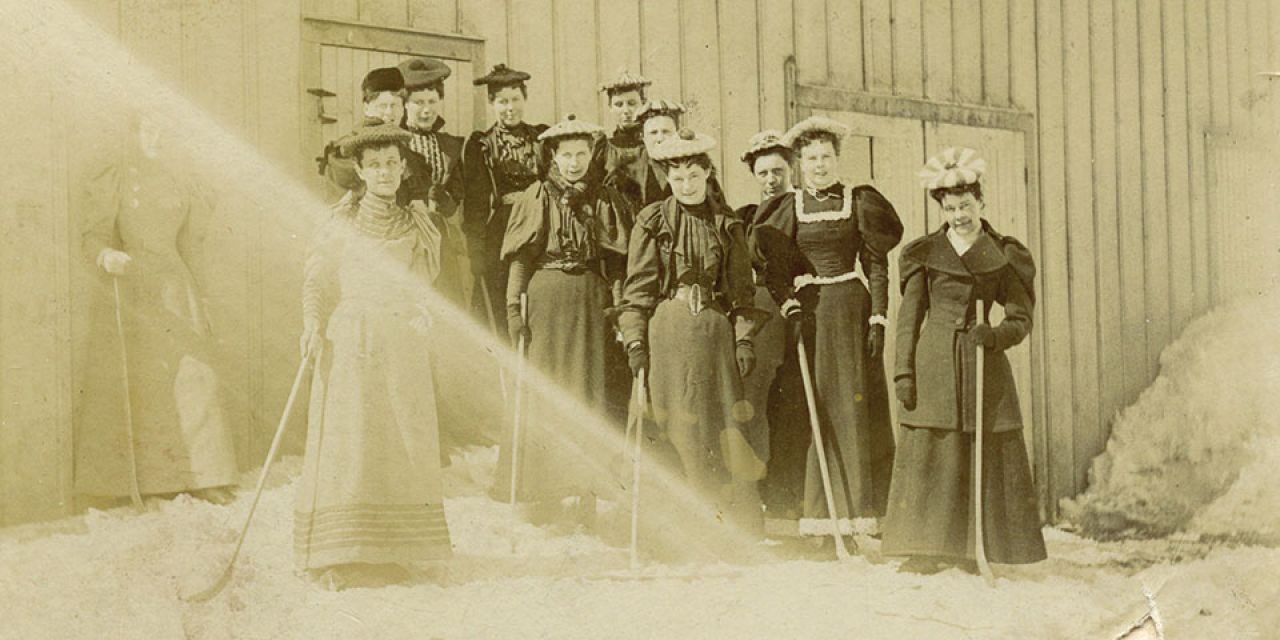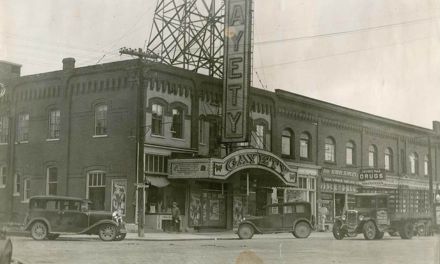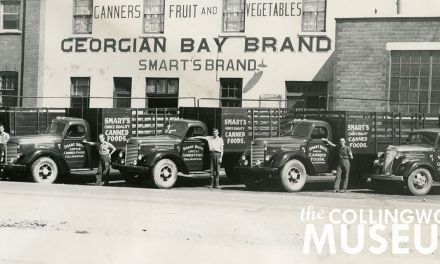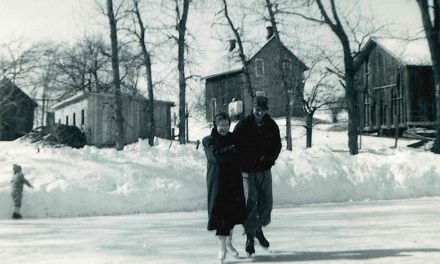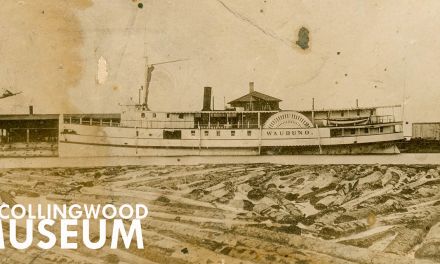Twelve members of the Collingwood Ladies Hockey Club stand in front of the Collingwood Skating Rink on Pine Street, circa 1898-99. Collingwood Museum Collection, X969.745.1.
Corsets & Corsages
by Melissa Shaw | photos courtesy of the Collingwood Museum
The untold story of Collingwood’s pioneering women on the ice—how they carved out space for women in hockey while battling the constraints of their era.
A photograph in the Collingwood Museum’s collection provides the first piece of evidence that women were playing hockey in Collingwood in the late 1890s. Women’s hockey didn’t join the Olympics until 1998—a century-long disparity! Men’s hockey, on the other hand, joined the Olympic arena in 1920, just 35 years after the first puck dropped in Collingwood.
The first time I saw the photograph of the Collingwood Ladies’ Hockey Club, I was immediately hooked. A group of twelve unnamed women in dresses, holding wooden hockey sticks, are pictured outside Collingwood’s Pine Street Arena between 1898 and 1899. But let’s back up for a second. Did you catch the key word here? Dresses… and not the loose-fitting dresses of the 1920s, but Victorian-era, tight-fitting, corset-required, breathing-restricted dresses.
These women must have been superheroes of their time. And certainly, they retain this status in the eyes of museum staff, as they remain the only documented female hockey players in the Collingwood Museum’s extensive collection.
Through detailed notes, we know that men’s hockey started in Collingwood in 1895, and the museum’s collection has numerous professional photographs of these early teams. The men pose in formal studios, wearing hockey uniforms, and typically, there is a dog or two for good measure. In some cases, there are duplicates and even triplicates of the same photograph with carefully documented names.
The photograph of Collingwood’s women’s team stands in sharp contrast: no names, no uniforms, and certainly no professional photographer or studio. Oh, and no dogs to be found. The only indication of their purpose is the wooden hockey stick each player holds in her hand.
A recent study of the museum’s early records reveals that this photograph is not listed in the published catalogue of the museum’s collection, despite being donated over a decade before the historical catalogue’s publication in 1937. Was it merely an oversight? How could the only photograph of women’s hockey be missed?
Women’s history is rather difficult to unearth. In many cases, women and their activities went unreported, or the women themselves remained unnamed, often referenced only by their husband’s names.
Perhaps you’ll think the women’s team didn’t play against other communities. Perhaps they didn’t win. But they did! They absolutely did. There are a handful of newspaper articles available at the Collingwood Public Library from 1897 that prove this point. Unfortunately, no articles could be found for the years in which the women’s hockey photograph is recorded to have been taken. There were, however, multiple entries detailing the exploits of the men’s team.
Women’s history is rather difficult to unearth. In many cases, women and their activities went unreported, or the women themselves remained unnamed, often referenced only by their husband’s names—for example, Mrs. Donald McKay, whose name was Elsie Stephens, was a member of Collingwood’s Ladies’ Hockey Club.
But wait a minute, didn’t I say the women were unidentified? It turns out that the names of these early hockey players were recorded alongside the photograph in the original scrapbook where all photograph donations were placed by the early curator of Collingwood’s first museum. However, these names became disassociated from the photograph when the scrapbook was taken apart following the fire that struck the Carnegie Library in 1963.
Just a few years ago, staff happened upon the handwritten names on the back of a photograph from 1911, documenting the day that Wilfrid Laurier visited Collingwood on his re-election campaign. Unfortunately, it seems more attention was given to preserving the 1911 photograph than safeguarding the women’s names.
We’re still missing some first and last names, but we’re certainly on our way to reassembling the members of the Collingwood Ladies’ Hockey Club.
The handwriting reveals: The Collingwood Ladies’ Hockey Club, about 1898–1899. Including: Flo Elworthy, Emma Elworthy, L. Carpenter, Hattie Copeland, Jennie Carpenter, Helena Elworthy, Elsie McKay, Emma, Jennie Rigg. And three women with the last names Robertson, Lewis, and Williams.
This photograph was donated to the Huron Institute by Helena Elworthy in 1925. Nearly 125 years later, we continue to be astounded and inspired by the obstacles these women overcame, including the chauvinist reporting of their games in local newspapers. However, it’s important to keep in mind that these women were likely the exception, not the rule, in Collingwood at that time. Their names may be familiar to you because their families were prominent business owners, politicians, and lawyers. Their involvement in hockey as a leisure sport was likely unavailable to many other local women, who had rivaling priorities.
Let’s take inspiration from these pioneering women and celebrate the courage it takes to push against norms. Their story reminds us that women have always made their mark, even when unrecorded. These trailblazers on the ice are proof that, with persistence, barriers can be overcome—stories like theirs are woven into the fabric of every community, waiting to be uncovered and told. E

